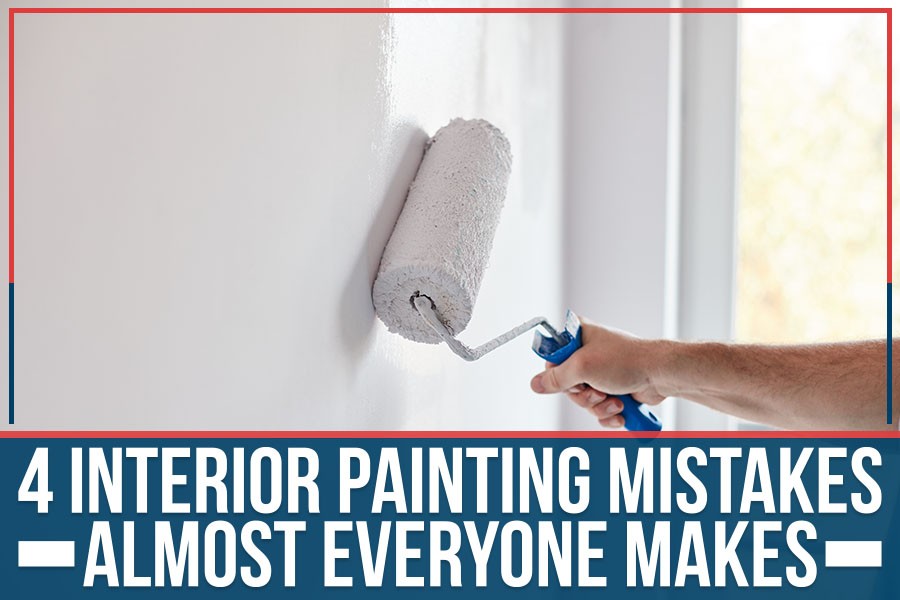4 Interior Painting Mistakes Almost Everyone Makes
Enhancing Every Corner: Exploring the World of Residential Interior Painters

Table of Contents
The sphere of residential interior painting encapsulates a broad range of craftsmanship and artistic talent, which goes beyond the mere application of color to walls. This domain involves strategic aesthetic decisions, meticulous preparation, and expert application techniques that can drastically transform a living space, enhancing every corner. The focus of this discourse is on residential interior painters - the individuals who masterfully wield their paintbrushes to breathe life into our homes.
This exploration extends across various facets associated with these professionals. It delves into understanding their roles, identifying different types within the industry, and elucidating the process they follow for interior painting jobs. Furthermore, it provides insights on how one might select an appropriate painter for specific projects while also offering tips on maximizing value from such endeavors. In essence, this article aims to shed light on the world of residential interior painters – a group whose creative prowess significantly impacts our everyday living spaces.
Residential interior painters play a pivotal role in establishing the aesthetic appeal of homes by meticulously applying layers of paint to walls, ceilings, and other structures, thereby transforming ordinary living spaces into visually stunning environments. This profession requires a combination of technical skills and artistic creativity to ensure that the chosen colors complement the overall design aesthetics while also addressing practical considerations such as durability and maintenance. The impact of their work extends beyond mere visual enhancement; it contributes significantly to the creation of an atmosphere that reflects the personality and lifestyle preferences of the residents.
The process involved in residential interior painting encompasses several stages, ranging from preparation and priming to final application and finishing touch-ups. These professionals engage in detailed consultations with clients to understand their vision for space before commencing work, ensuring that each project aligns with client's expectations. Additionally, they must possess comprehensive knowledge about various types of paints, application techniques, color psychology, as well as safety practices related to handling paint materials. Henceforth, residential interior painters do not just splash colors on walls; they are experts who leverage their skills and expertise towards enhancing residential interiors - making them vibrant embodiments of homeowner's tastes and preferences.
Various classifications exist within the realm of professionals who specialize in applying paint to indoor spaces, each differing in their approach, expertise, and area of focus. On one end of the spectrum are general interior painters. These individuals or companies provide a broad range of services encompassing all types of spaces within residential properties - bedrooms, kitchens, bathrooms, living rooms, and so forth. Their competencies include surface preparation, understanding how different colors interact with lighting conditions and human perception, selecting the right type of paint for different surfaces and environmental conditions.
Another category is specialized interior painters whose knowledge extends beyond conventional painting techniques to cover specific styles or settings. For instance, decorative painters are experts at creating unique visual effects on walls such as faux finishes (marbling or wood graining), murals or detailed patterns that mimic wallpaper designs. Meanwhile historic preservationists concentrate on restoring old homes to their original condition which often involves researching historical color palettes and using traditional application methods that respect the architectural integrity of these residences. Lastly are commercial interior painters who primarily work on large scale projects like apartment complexes or office buildings where efficiency and adherence to strict timelines become crucial factors alongside quality assurance measures.
Undertaking the task of interior painting necessitates a systematic and meticulous process that begins with planning and ends with a thorough clean-up, ensuring the transformation of indoor spaces into aesthetically pleasing environments. The planning phase involves choosing the desired colour scheme, determining the type of paint suitable for the room's conditions, such as latex or oil-based paints, and calculating how much paint is needed based on room size. In preparation for painting, all furniture is moved or covered to protect it from potential splatters; walls are cleaned to remove dust or grease that might interfere with paint adhesion; cracks or holes are filled in; and primer is applied if necessary.
The next steps involve applying layers of the chosen paint using rollers or brushes. This application process often includes cutting-in, which entails painting corners or edges first before filling in larger wall areas—a technique that ensures consistent coverage and minimises streaking. Following this step-by-step approach assures an evenly painted surface that meets aesthetic expectations. After all surfaces have been sufficiently coated and allowed enough time to dry, there comes a crucial final stage: cleaning up. This involves removing all protective coverings from furniture and floors, washing brushes and rollers thoroughly for future use, disposing of any leftover paint cans and materials used during the process. Thus concludes a typical interior painting project—meticulous yet satisfying in its capacity to rejuvenate residential interiors.
Selecting the most suitable professional for your painting project requires careful consideration and evaluation of their expertise, experience, and credibility in the field. This begins with conducting comprehensive research on available professionals within one's locality, gathering recommendations from friends or family members who have previously engaged such services, and scrutinizing reviews on various online platforms. It is also critical to validate the painters' credentials by verifying their licensing and insurance status, which ensures protection against potential liability issues during the project. Additionally, a painter's portfolio should be evaluated to ascertain their ability to deliver according to an individual's specific needs and preferences.
In addition to these fundamental factors, potential clients are advised to seek detailed quotations from multiple painters for comparison purposes. These quotes should provide exhaustive information about labor costs, material expenses, timeframes for completion among other important aspects of the project. A professional painter will not only provide a transparent quote but also explain each detail clearly ensuring there are no hidden charges or uncertainties about what is included in their service offering. Furthermore, excellent communication skills and customer service orientation are desirable qualities in a painter as they foster understanding and satisfaction throughout the course of the project. As such, taking time in choosing a residential interior painter significantly influences the success of a painting project while simultaneously enhancing value for money spent.
In the sphere of interior painting projects, several factors contribute to enhancing their overall value, including maintenance practices, the application of color trends and ideas, and the adoption of sustainable and eco-friendly options. The implementation of appropriate maintenance tips ensures longevity and aesthetic appeal, while staying abreast with color trends and ideas can significantly influence the ambiance and perceived space within a room. Furthermore, sustainability considerations play a crucial role in today's environmentally conscious society where options that minimize environmental impacts are not just appreciated but expected.
Regular upkeep of residential interior paintwork significantly extends its longevity and maintains the aesthetic appeal of the space. Proper maintenance can also prevent minor damages from escalating into major issues that require costly repairs. For instance, timely cleaning can remove dirt, dust, and grime buildup that may eventually cause discoloration or peeling. Furthermore, periodic inspection allows early detection of any signs of wear or damage such as chipping or cracking paint. Once these signs are identified, prompt action such as touch-up painting can be taken to restore the surface's original condition.
In addition to regular cleaning and inspection, preventive measures also play a crucial role in maintaining interior paintwork. These include using high-quality paints with superior durability and resistance to common forms of damage like moisture absorption or UV exposure. It is also advisable to apply protective finishes for added protection against potential harm caused by daily use or environmental factors. On another note, careful handling of furniture and other items within painted spaces reduces physical impact on the surfaces, thereby reducing chances of scratch marks or dents on the painted walls. Henceforth, a comprehensive approach involving both corrective actions and preventive strategies ensures optimal preservation of residential interior paintwork.
Keeping abreast of the latest color trends and creative ideas can lead to captivating, modern, and stylish aesthetics for home interiors. The popularity of colors in interior design is not static; it evolves with time, reflecting changes in societal attitudes, technological advancements, and artistic innovation. For instance, the 2020s have seen a shift towards calming hues such as soft blues and greens that promote tranquility amidst the bustling pace of modern life. On the other hand, bold colors like deep reds and rich purples are also gaining traction for their ability to create vibrant and lively atmospheres.
Adopting these trends should not be a mere process of imitation but rather an exercise in creativity. In this regard, blending different color palettes or adding unique textures can result in a personalized space that reflects individual preferences while remaining fashionable. Moreover, incorporating elements such as lighting fixtures or furniture pieces can further enhance the overall aesthetic appeal by creating contrasts or harmonies with chosen paint colors. Therefore, keeping up-to-date with current color trends and exploring innovative ideas offer significant benefits for residential interior painting projects by allowing homeowners to construct visually stunning environments that cater to their specific tastes and lifestyles.
Eco-conscious homeowners are increasingly turning towards sustainable and eco-friendly options for their home painting needs, which not only reduce the environmental footprint but also contribute to healthier indoor air quality. This shift in consumer preferences has encouraged an increase in the production of paints that are devoid of volatile organic compounds (VOCs), which are harmful chemicals released into the air during and after painting. These low-VOC or zero-VOC paints, as they are commonly known, have gained considerable traction because they offer the same durability and finish as conventional paints without compromising on health and environmental safety. Major paint manufacturers have responded by offering a wide range of these products with numerous color options.
In addition to low-VOC paints, there is increasing interest in natural or organic-based paints made from renewable resources such as plant oils and resins, clay, chalk, milk casein, lime, and even beeswax. These bio-based materials provide a viable alternative to synthetic substances traditionally used in paint production. They are biodegradable and compostable at the end of their life cycle thus reducing waste generation significantly. Many residential interior painters now advocate for these sustainable choices due to their minimal impact on the environment while still providing high-quality finishes that meet aesthetic desires of homeowners.
The selection of a suitable residential interior painter plays a significant role in enhancing aesthetics and value of a home. It is essential to understand the types, process, and factors involved in selecting an appropriate painter for a successful interior painting project.
Furthermore, maximizing the value of such projects requires careful planning and understanding. Contemplating color schemes, paint types, and utilizing professional help can contribute significantly in achieving desired results. Thus, residential interior painting serves as an indispensable tool in home improvement endeavors.
Author

Mason Marquis, raised in Newport Beach, California, and Austin, Texas, amalgamated his experiences from both vibrant cities in his journey. His academic pursuit in Economics and Psychology at the University of North Texas (UNT) led to the founding of Spray Tex Painting. This venture was not just a business for Mason but a practical application of his academic learnings, particularly the integration of economic concepts and psychological understanding. Spray Tex Painting, under Mason's direction, transcends being merely a painting service; it's a platform where client visions are realized through dedication and creativity.
Related Articles

4 Interior Painting Mistakes Almost Everyone Makes

4 Tips For Upgrading The Paint At Your Food Joint

5 Unique Texture Painting Ideas to Add Depth to Your Walls

A Comprehensive Approach: Unveiling the Whole-house Paint Services